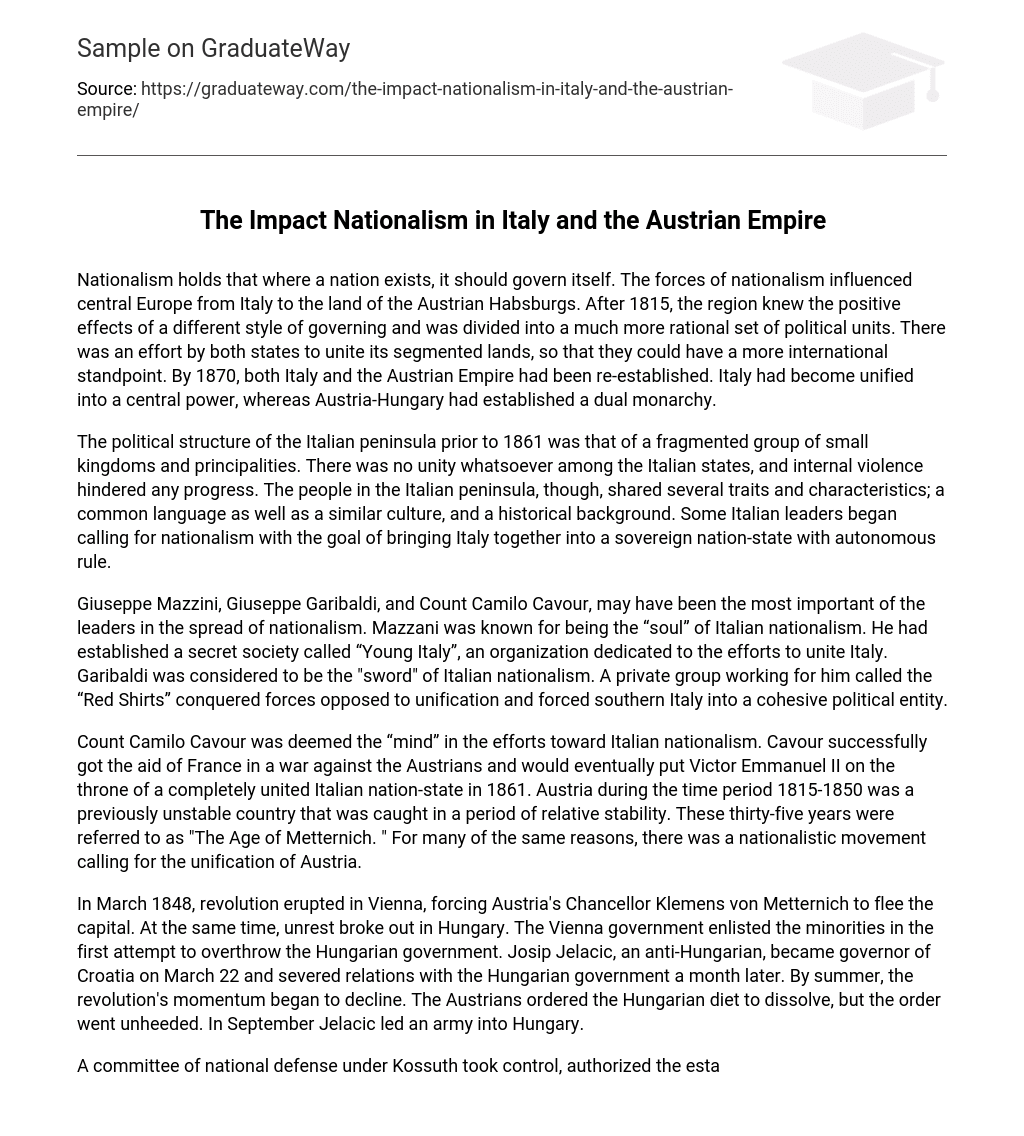Nationalism holds that where a nation exists, it should govern itself. The forces of nationalism influenced central Europe from Italy to the land of the Austrian Habsburgs. After 1815, the region knew the positive effects of a different style of governing and was divided into a much more rational set of political units. There was an effort by both states to unite its segmented lands, so that they could have a more international standpoint. By 1870, both Italy and the Austrian Empire had been re-established. Italy had become unified into a central power, whereas Austria-Hungary had established a dual monarchy.
The political structure of the Italian peninsula prior to 1861 was that of a fragmented group of small kingdoms and principalities. There was no unity whatsoever among the Italian states, and internal violence hindered any progress. The people in the Italian peninsula, though, shared several traits and characteristics; a common language as well as a similar culture, and a historical background. Some Italian leaders began calling for nationalism with the goal of bringing Italy together into a sovereign nation-state with autonomous rule.
Giuseppe Mazzini, Giuseppe Garibaldi, and Count Camilo Cavour, may have been the most important of the leaders in the spread of nationalism. Mazzani was known for being the “soul” of Italian nationalism. He had established a secret society called “Young Italy”, an organization dedicated to the efforts to unite Italy. Garibaldi was considered to be the “sword” of Italian nationalism. A private group working for him called the “Red Shirts” conquered forces opposed to unification and forced southern Italy into a cohesive political entity.
Count Camilo Cavour was deemed the “mind” in the efforts toward Italian nationalism. Cavour successfully got the aid of France in a war against the Austrians and would eventually put Victor Emmanuel II on the throne of a completely united Italian nation-state in 1861. Austria during the time period 1815-1850 was a previously unstable country that was caught in a period of relative stability. These thirty-five years were referred to as “The Age of Metternich. ” For many of the same reasons, there was a nationalistic movement calling for the unification of Austria.
In March 1848, revolution erupted in Vienna, forcing Austria’s Chancellor Klemens von Metternich to flee the capital. At the same time, unrest broke out in Hungary. The Vienna government enlisted the minorities in the first attempt to overthrow the Hungarian government. Josip Jelacic, an anti-Hungarian, became governor of Croatia on March 22 and severed relations with the Hungarian government a month later. By summer, the revolution’s momentum began to decline. The Austrians ordered the Hungarian diet to dissolve, but the order went unheeded. In September Jelacic led an army into Hungary.
A committee of national defense under Kossuth took control, authorized the establishment of a Hungarian army, and issued paper money to fund it. In October 1848, imperial troops entered Vienna and stifled a workers’ rebellion, effectively ending the revolution everywhere in the empire except Hungary, where Kossuth’s army had overcome Jelacic’s forces. A few months later, Austrian forces had overwhelmed the Hungarians, and Kossuth escaped into the Ottoman Empire. After the revolution, the emperor revoked Hungary’s constitution and assumed absolute control.
Hungarian public opinion split over the country’s relations with Austria. Some Hungarians held out hope for full separation from Austria; others wanted an accommodation with the Habsburgs, provided that they respected Hungary’s constitution and laws. This almost nearly absolutist rule was faulted when French and Sardinian forces defeated Austria at Solferno. Austria and Hungary thus moved toward a compromise. In 1866 the Prussians defeated the Austrians, further emphasizing the weakness of the Habsburg Empire.
Negotiations between the emperor and the Hungarian leaders were increased and finally resulted in the Compromise of 1867, which created the Dual Monarchy of Austria and Hungary, also known as the Austro-Hungarian Empire. Both Italy and Austria-Hungary had had a form of unification. In Italy, however, the unification was all internal, that is, within the Italian peninsula. Austria on the other hand, had formed a dual alliance with Hungary in order to create a stronger empire which could withstand any further attacks on them. Works Cited Metcalf, Adam S. “Unification. ” 2001.
Nationalism: Political Revolutions. Regents Prep. 19 Nov. 2004 . Musulin, Stella. Vienna in the Age of Metternich: From Napoleon to Revolution, 1805-48. : Westview Press, 1975. “National Rivalries. ” National Rivalries. The Corner. 19 Nov. 2004 . Smith, Denis Mack. Mazzini. New Haven: Yale University Press, 1994. Taylor, Alan J. The Habsburg Monarchy, 1809-1918: A History of the Austrian Empire and Austria-Hungary. Chicago: University of Chicago Press, 1987. Wawro, Geoffrey. Austro-Prussian War: Austria’s War with Prussia and Italy in 1866. Cambridge: Cambridge University Press, 1997.





